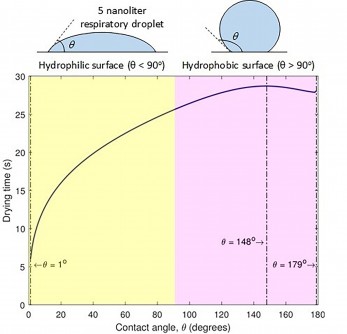Drying time of a 5-nanoliter droplet as a function of the contact angle on the surface. Courtesy of R. Bhardwaj and A. Agrawal
Since the COVID-19 virus spreads through respiratory droplets, researchers in India set out to explore how droplets deposited on face masks or frequently touched surfaces, like door handles or smartphone touch screens, dry.
Droplets can be expelled via the mouth or nose while coughing, sneezing or simply talking. These droplets are tiny, around twice the width of a human hair, and studies have shown a substantially reduced chance of infection once they dry.
In Physics of Fluids, Rajneesh Bhardwaj and Amit Agrawal, professors at IIT Bombay, publish findings that surface wetting properties to reduce the drying time of droplets could help lessen the risk of infection from coronaviruses.
“We wanted to quantify the droplet drying time on various surfaces and make a recommendation for the ideal types of surfaces for masks and personal protective equipment (PPE) based on the drying time,” said Bhardwaj.
By studying the drying time of a droplet for different contact angles, the expected chances of survival of the coronavirus on a surface can be estimated by using a mathematical physics model.
“Our calculations of the drying time as a function of contact angle show that the droplet dries roughly four times faster on the hydrophilic surface that attracts water than on the one that repels water. This will drastically reduce the chances of virus survival,” Bhardwaj said.
Their work also shows that, by tailoring the surface wettability and drying time, the chances of infection can be reduced.
“Making a surface more hydrophilic reduces the drying time, and it is advisable to use it for masks, PPE and frequently touched surfaces where outbreaks are most likely to occur, such as the common areas within hospitals,” said Agrawal.
In the case of N95 respirators, surgical masks and PPE bodywear, a reduction to a contact angle of a hydrophilic surface implies that the chances of infection of COVID-19 will be cut in half.
“We recommend reducing the contact angle of the surface of face masks and frequently touched surfaces,” Agrawal said.
The biggest surprise was their finding that the maximum drying time occurs at an intermediate contact angle value of 148 degrees.
“This implies that a superhydrophobic surface needs to be made even more superhydrophobic to reduce the drying time,” Agrawal said. “This is counterintuitive, because we normally think of making a surface more hydrophilic, reducing the contact angle, to reduce the drying time.”
This work provides a better understanding of coronavirus survival within a drying droplet, which may be helpful for predicting the survival of other transmissible diseases spread through respiratory droplets, such as the flu.
Source: American Institute of Physics (AIP)

Be the first to comment on "Masks, PPE Materials Should Be Hydrophilic"